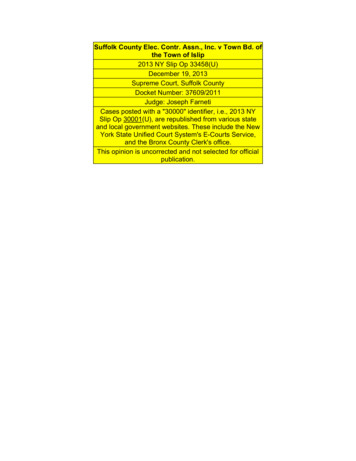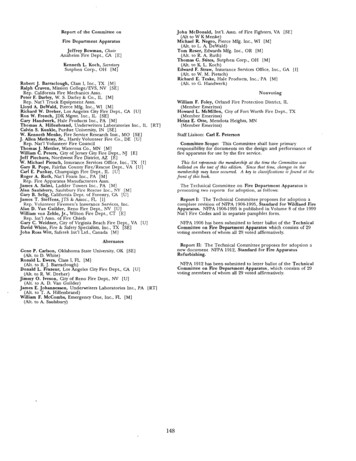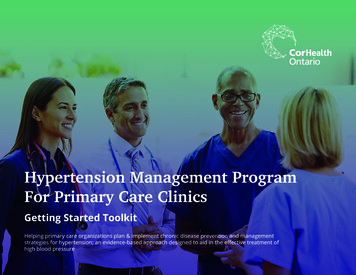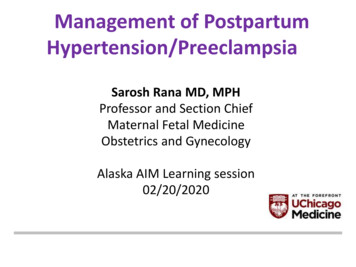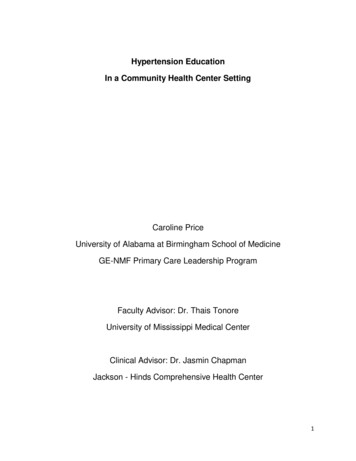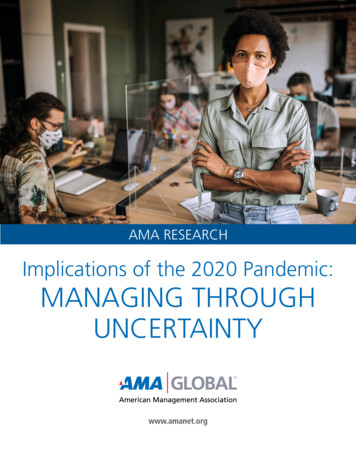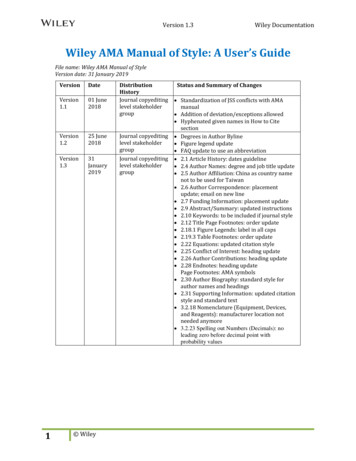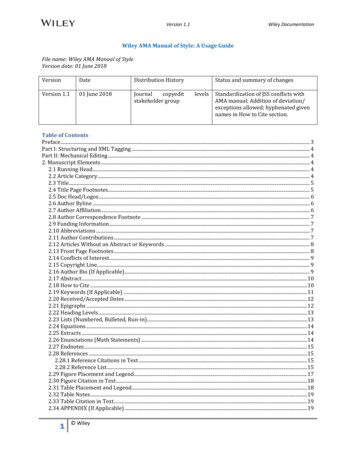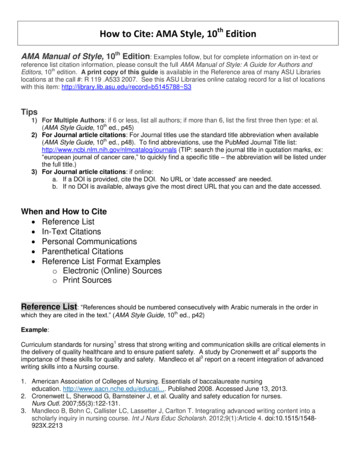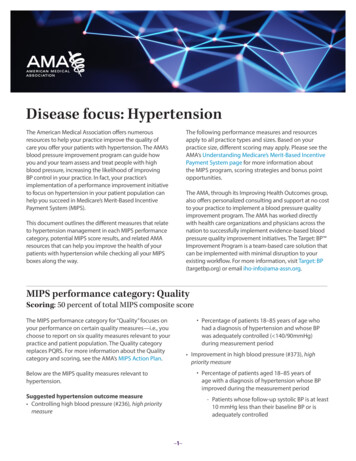
Transcription
Disease focus: HypertensionThe American Medical Association offers numerousresources to help your practice improve the quality ofcare you offer your patients with hypertension. The AMA’sblood pressure improvement program can guide howyou and your team assess and treat people with highblood pressure, increasing the likelihood of improvingBP control in your practice. In fact, your practice’simplementation of a performance improvement initiativeto focus on hypertension in your patient population canhelp you succeed in Medicare’s Merit-Based IncentivePayment System (MIPS).The following performance measures and resourcesapply to all practice types and sizes. Based on yourpractice size, different scoring may apply. Please see theAMA’s Understanding Medicare’s Merit-Based IncentivePayment System page for more information aboutthe MIPS program, scoring strategies and bonus pointopportunities.The AMA, through its Improving Health Outcomes group,also offers personalized consulting and support at no costto your practice to implement a blood pressure qualityimprovement program. The AMA has worked directlywith health care organizations and physicians across thenation to successfully implement evidence-based bloodpressure quality improvement initiatives. The Target: BP Improvement Program is a team-based care solution thatcan be implemented with minimal disruption to yourexisting workflow. For more information, visit Target: BP(targetbp.org) or email iho-info@ama-assn.org.This document outlines the different measures that relateto hypertension management in each MIPS performancecategory, potential MIPS score results, and related AMAresources that can help you improve the health of yourpatients with hypertension while checking all your MIPSboxes along the way.MIPS performance category: QualityScoring: 50 percent of total MIPS composite scoreThe MIPS performance category for “Quality” focuses onyour performance on certain quality measures—i.e., youchoose to report on six quality measures relevant to yourpractice and patient population. The Quality categoryreplaces PQRS. For more information about the Qualitycategory and scoring, see the AMA’s MIPS Action Plan. Percentage of patients 18–85 years of age whohad a diagnosis of hypertension and whose BPwas adequately controlled ( 140/90mmHg)during measurement period Improvement in high blood pressure (#373), highpriority measure Percentage of patients aged 18–85 years ofage with a diagnosis of hypertension whose BPimproved during the measurement periodBelow are the MIPS quality measures relevant tohypertension.Suggested hypertension outcome measure Controlling high blood pressure (#236), high prioritymeasure-- Patients whose follow-up systolic BP is at least10 mmHg less than their baseline BP or isadequately controlled–1–
Disease focus: HypertensionSuggested hypertension process measure Hypertension screening and recommended follow upplan (#317)BP positioning challenge addressed by web-based toolTest your knowledge on how to resolve positioningissues and get an accurate reading. Percentage of patients aged 18 years and olderseen during the submitting period who werescreened for high BP and a recommended followup plan is documented based on the current BPreading as indicatedUsing wrist cuff to measure blood pressure—a helpful handoutFor those instances when an upper arm cuff won’t fit,this piece explains how to use a wrist cuff correctly.TOOLS FOR #236/373: Focus on management ofhypertension and partnering with patientsBP treatment algorithmOutlines recommended treatment for each BP threshold.AMA resources: Target: BPThe AMA, has created tools and resources for providersto improve accuracy of hypertension diagnosis andBP control through the Target: BP blood pressureimprovement program. Below are some of the resourcesthat clinical care teams can use to improve qualityof care, and that can lead to greater success in MIPSreporting.Blood pressure average calculatorHelps your patients keep track as they measure andmonitor their BP.Collaborative communication strategies tomanage blood pressureHighlights the ways to collaborate with your patients tocontrol BP, including five communication skills that canhelp improve engagement and shared decision-making.TOOLS FOR #317/236/373: Focus on accuratemeasurement of BPPractice assessment tool for M.A.P.—Measure, Act, PartnerTake a quick assessment to learn where you are doingwell and where you can improve.Device accuracy testUse this resource to verify that a patient’s BPmeasurement device is properly calibrated to deliveraccurate measurements.BP measurement technique quick-check worksheetHelp ensure that everyone in your practice takes BPreadings the right way—and the same way—every time.Blood pressure measurement posterThis piece highlights the proper steps to take whenmeasuring blood pressure, with evidence-based tips forcorrect positioning.Patient training reference guideEnsures that designated staff has everything they needto train patients to self-measure blood pressure at home.Self-measured blood pressure training videoEducational video helps care teams train patients toself-measure and serves as a resource that patients canuse to reinforce how to properly self-measure bloodpressure. This video is also available in Spanish.Measuring blood pressure accurately patienthandout/posterMaterials show the critical steps for measuring BPaccurately, along with the potential impact thosemismeasurements may hold.MIPS performance category: Promoting Interoperability( formerly “Advancing Care Information”)Scoring: 25 percent of the MIPS composite scorePromoting Interoperability (PI) is about using certifiedelectronic health record technology (CEHRT) and thehealth care information that your practice captures in ameaningful way. PI is the new name for the AdvancingCare Information (ACI) category. For more informationabout the PI category and scoring, see the AMA’s MIPSAction Plan.–2–
Disease focus: HypertensionSuggested hypertension relevant PI MEASURES Patient-specific education (PI PEA 2 or PI TRANSPSE 1)Effects of excess sodium on your healthInfographic that demonstrates the effects excessivesodium intake can have on one’s health and appearance. The MIPS-eligible clinician must use clinicallyrelevant information from CEHRT to identifypatient-specific educational resources and provideaccess to those materials to at least one uniquepatient seen by the MIPS-eligible clinician.High blood pressure and strokeExplain the risks associated with high blood pressure,including stroke.How can I monitor cholesterol, blood pressure and weight?Helps patients with increased risk for heart disease orstroke work with you to monitor their risk and manage it. Patient-generated health data (PI CCTPE 3) Patient-generated health data or data from a nonclinical setting is incorporated into the CEHRTfor at least one unique patient seen by the MIPSeligible clinician during the performance period.RESOURCES TO USE FOR PATIENT-SPECIFICEDUCATION (PI PEA 2 or PI TRANS PSE 1) FORPATIENTS DIAGNOSED WITH HYPERTENSIONWhat is high blood pressure medication?Brief overview of the medicines prescribed to help lowerblood pressure and their possible side effects.Target: BPThe Target: BP Improvement Program has created toolsand resources that can be used to educate patientsabout blood pressure measurement and control. Beloware some of the available resources that clinical careteams can integrate into practice and use to successfullymeet MIPS PI measure reporting.How do I manage my medication?An informational piece that outlines strategies formedication adherence.Questions to ask your doctorHelps patients ask important questions about highblood pressure.RESOURCES FOR PATIENT-SPECIFIC EDUCATION (PIPEA 2 or PI TRANS PSE 1) FOR ALL PATIENTSUnderstand your BP numbersHelps patients determine what category their bloodpressure falls under.What can I do to improve my blood pressure?Use this piece to highlight five lifestyle modificationsthat can improve blood pressure for patients diagnosedwith hypertension.How to measure blood pressure accuratelyHelps patients ensure they are getting accurate bloodpressure readings.Why should I limit sodium?Helps patients understand why too much salt can causeproblems, gives tips on which foods to avoid and how tocook tasty food using less salt.What is high blood pressure?This piece explains the basics of high blood pressure,including key statistics, risk factors and informationabout treatment.RESOURCES TO USE FOR PATIENT-GENERATEDHEALTH DATA (PI CCTPE 3; please note that thismeasure is only applicable to practices using 2015Edition CERHT)Seven-day recording logHelps patients record their blood pressure readings.Consequences of high blood pressureInfographic demonstrates how high blood pressureaffects the body.Seven salty mythsThis piece delivers guidance that dispels seven commonmyths about sodium intake.–3–
Disease focus: HypertensionMIPS performance category: Improvement ActivitiesScoring: 15 percent of total MIPS composite scoreThe Improvement Activities (IA) category is a new areaof reporting that incentivizes practices to delve moredeeply to find opportunities to improve care delivery,access, and patient engagement. For more informationon IA and MIPS scoring, see the AMA’s MIPS Action Plan.data in a separate queue for clinician recognitionand review. Engagement of patients through implementation ofimprovements in patient portal (IA BE 4) Access to an enhanced patient portal thatprovides up-to-date information related torelevant chronic disease health or blood pressurecontrol, and includes interactive features allowingpatients to enter health information and/orenables bidirectional communication aboutmedication changes and adherence.Suggested hypertension relevant IA Chronic care and preventative care management forempaneled patients (IA PM 13) Proactively manage chronic and preventive carefor empaneled patients that could include one ormore of the following: Use evidence-based decision aids to support shareddecision-making (IA BE 12)-- Provide patients annually with an opportunityfor development and/or adjustment of anindividualized plan of care as appropriate toage and health status, including health riskappraisal; gender, age and condition-specificpreventive care services; and plan of care forchronic conditions Use evidence-based decision aids to supportshared decision-making. Completion of the AMA STEPS Forward program(IA PSPA 9) Completion of the AMA STEPS Forward program.-- Use condition-specific pathways for careof chronic conditions (e.g., hypertension,diabetes, depression, asthma and heartfailure) with evidence-based protocols toguide treatment to target, such as a CDCrecognized diabetes prevention programTarget: BPThe AMA has tools and resources that can be used forevidence-based decision-making, reporting patientoutcomes and physician education. Below are some ofthe resources available through Target: BP that will helpachieve success in the IA category.-- Use pre-visit planning to optimize preventivecare and team management of patients withchronic conditionsRESOURCES TO USE FOR EACH RELEVANT IA IA BE 1, Use of certified EHR to capture patientreported outcomes-- Use panel support tools (registry functionality)to identify services due Seven-day recording logHelps patients record their blood pressurereadings.-- Use predictive analytical models to predictrisk, onset and progression of chronic diseases-- Use reminders and outreach (e.g., phonecalls, emails, postcards, patient portals andcommunity health workers where available) toalert and educate patients about services due,and/or routine medication reconciliation IA BE 12, Use evidence-based decision aids tosupport shared decision-making BP treatment algorithm websiteOutlines recommended treatment for each BPthreshold. Use of certified EHR to capture patient-reportedoutcomes (IA BE 1) Understand your BP numbersHelps patients determine what category theirblood pressure falls under. In support of improving patient access,performing additional activities that enablecapture of patient-reported outcomes (e.g., homeblood pressure, blood glucose logs, food diaries,at-risk health factors such as tobacco or alcoholuse, etc.) or patient activation measures throughuse of certified EHR technology, containing this What can I do to improve my high blood pressure?Highlights five lifestyle modifications that canimprove blood pressure for patients diagnosedwith hypertension.–4–
Disease focus: HypertensionOTHER NOTES IA BE 4 would be applicable if using an enhancedpatient portal to collect self-monitored blood pressurelogs and provide blood pressure management/medication advice IA PSPA 9, Completion of AMA STEPS Forwardprogram “Improving blood pressure control” module}CME module on how to Measure, Act, Partner(M.A.P.) to help patients control blood pressureand ultimately prevent heart disease. IA PM 13 is applicable if using Target: BP program ortools to provide patients with individual plan of carefor hypertension management annually or to guidetreatment of hypertensionMIPS performance category: CostScoring: 10 percent of total MIPS composite scoreThe “Cost” performance category uses your Medicareclaims data to collect Medicare payment informationfor the care you gave to beneficiaries during a specificperiod of time. CMS will calculate your “Cost” categoryscore, and you don’t have to submit any data. For moreinformation, see the AMA’s Cost FAQ. 2018 American Medical Association. All rights reserved. 17-248037:7/18–5–
Improvement Program is a team-based care solution that can be implemented with minimal disruption to your existing workflow. For more information, visit Target: BP (targetbp.org) or email iho-info@ama-assn.org. MIPS performance category: Quality Scoring:
